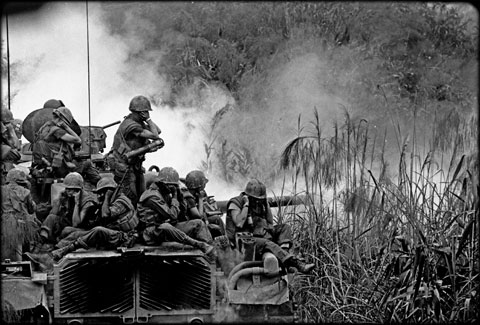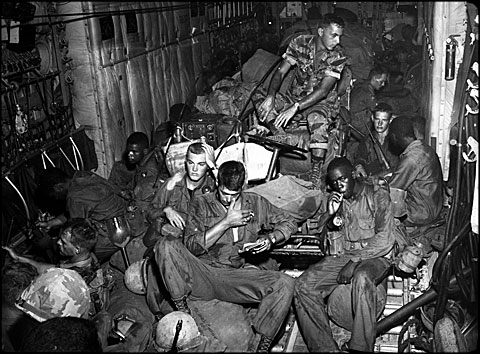 |
||||||||||||
|
January/February 2015
Four Decades Later: Vietnam Veterans BY WILLIAM E. SCHLENGER AND NIDA H. CORRY On March 25, 1973, the role of overt American intervention in the Republic of Vietnam ended. On May 7, 1975, President Gerald R. Ford proclaimed the end of the “Vietnam era.” Nearly a decade later, Congress asked the VA Administrator to conduct “a comprehensive study of the prevalence and incidence in the population of Vietnam veterans of post-traumatic stress disorder (PTSD) and other psychological problems in readjusting to civilian life.” That study, funded by the VA and based on independent peer review, became known as the National Vietnam Veterans Readjustment Study (NVVRS). Its findings became the empirical basis for many policy changes on veterans health. Decades later, Congress asked the Secretary of Veterans Affairs to “enter into a contract with an appropriate entity to carry out a study on post-traumatic stress disorder using the database and sample of the previous study.” This follow-up study, known as the National Vietnam Veterans Longitudinal Study (NVVLS), was also funded by the VA. Based on peer review, it was designed, implemented, analyzed, and interpreted by a multidisciplinary team of health and mental health professionals from Abt Associates (a leading health and social science research firm) and the Department of Psychiatry at New York University. That group included three co-principal investigators from the first study. The research team submitted the new study to the VA in December 2013. The VA shared the findings with Congress in August 2014. What follows are some preliminary findings about Vietnam veterans for the 25-year span between the 1986-88 NVVRS and the 2012-13 NVVLS.
The NVVLS is a follow-up study of two cohorts of veterans who participated in the original NVVRS study: service members who were deployed to the Vietnam War (“theater veterans”), and a comparison group who served during the Vietnam era but were not deployed to the Vietnam theater (“era veterans”). For theater veterans, warzone stress exposure and other combat-related experiences were assessed in the original NVVRS during hour-long interviews. Dimensions of warzone stress included combat exposure, abusive violence, deprivation, loss of meaning, prisoner of war status, and exposure to the wounded and dead. A quarter of theater veterans living today reported high levels of warzone stress exposure, versus low to moderate for the others. In both studies, all veterans were assessed for postwar physical and mental health problems. Some veterans also were interviewed by experienced mental health clinicians, who focused on PTSD, major depression, and substance abuse. The NVVLS follow-up assessment of the veterans’ physical and mental health was conducted via three components: (1) a self-report survey booklet; (2) a telephone interview with an experienced survey interviewer; and (3) for some randomly selected veterans, a diagnostic mental health interview conducted over the phone by a well-trained, experienced, and licensed mental health clinician. Of the 1,839 veterans who were eligible, 1,450 participated in one or more components, a response rate of 79 percent.
Mortality. Because more than twenty years had passed when the follow-up began, the initial challenge was to locate the NVVRS participants. We checked two national death registries and found that, as of April 2011, 428 of the 2,348 participants had died. Death certificate information indicated that the majority of deaths were due to chronic and non-communicable diseases (78.7 percent) or external causes, such as injuries, suicide, and drug overdose. Analyses of these data indicate that male theater veterans who had PTSD in 1987 were nearly twice as likely to have died compared to those who did not have PTSD, and that male and female theater veterans with high exposure to warzone stress were also nearly twice as likely to have died than those with low or moderate warzone stress exposure. Demographics. The average age of the living Vietnam theater veterans as of 2013 was 67. Twenty-eight percent of all living theater veterans were high school graduates; 38.3 percent took college course work; and 26.7 percent completed college. Among theater veterans, more women than men completed college (69.9 percent vs. 26.6 percent). More than half (58.6 percent) of all theater veterans in the NVVLS were retired; one-third (33.3 percent) were working. In 2012-13, more than one-third of era veterans reported annual family income of more than $75,999. Approximately 12.1 percent reported family income of less than $25,000. The household income of the majority of theater veterans supported two people (63.6 percent); one-fifth (20.2 percent) supported only one person. Female theater veterans were twice as likely as their male counterparts to support only one person with their household income. Male theater veterans were more likely to support two to four people. Mental Health. Among theater veterans, we found that the prevalence of current PTSD based on full DSM-5 criteria (see a summary of DSM-5 criteria in the PTSD/SA Committee Report) to be about 11 percent for male and 7 percent for female theater veterans. Based on these rates, we estimate that some 283,000 male and 400 female theater veterans had warzone PTSD in 2012-13, forty or more years after their wartime service. We also found that 3 percent of theater veterans had many PTSD symptoms but fell short of meeting the DSM-5 criteria, referred to as “subthreshold warzone PTSD.” Extrapolating from these estimates, about 83,500 male and 150 female veterans had subthreshold warzone PTSD in 2012-13. We also examined changes in PTSD symptom patterns from the late 1980s to the second assessment in 2012-13 by creating four categories of change: (1) low symptom levels at both times, (2) decreasing symptoms, (3) increasing symptoms, and (4) high symptoms at both times. We found that 75 percent of theater veterans reported low symptom levels at both times, 5 percent reported decreasing symptom levels, 13 percent reported increasing levels, and 7 percent reported consistently high symptom levels at both times. People with PTSD often meet criteria for other psychiatric disorders, particularly depression and substance abuse disorders. We found that 37 percent of theater veterans with current warzone PTSD also met criteria for major depression, and that 31 percent of those who have subthreshold warzone PTSD also met that criteria. By comparison, less than 1 percent of veterans without any PTSD met criteria for major depression. Among theater veterans meeting DSM-5 criteria for current warzone PTSD, 2 percent met criteria for current alcohol abuse. Only 0.7 percent of those with subthreshold PTSD and 3 percent of those without PTSD met criteria for current alcohol abuse. Assessments of current drug abuse in theater veterans indicated rates of 2 percent among current warzone PTSD cases, 2 percent among subthreshold cases, and 0.6 percent among those negative for PTSD. Physical Health. Not surprisingly, NVVLS veterans reported more chronic health conditions than they did in NVVRS, given that chronic conditions typically begin later in life. Males averaged 5.4 lifetime conditions, and females averaged 6.6. More than half of theater veterans reported musculoskeletal (e.g., arthritis, rheumatism) conditions. Nearly one-third reported circulatory (e.g., heart attack, hypertension) and nervous system (e.g., deafness, paralysis) diseases. Theater veterans with current warzone PTSD were more likely to report a host of chronic conditions (e.g., musculoskeletal, circulatory, nervous system, endocrine). Veterans with current warzone PTSD reported having more of these conditions than those who do not have current warzone PTSD. Use of Physical and Mental Health Services. Nearly 60 percent of Vietnam theater veterans reported receiving outpatient health care in the previous six months for physical health conditions. Of those who reported receiving outpatient care, 37 percent received care within the VA system. Male and female theater veterans whose PTSD symptoms remained elevated or worsened over time were more likely to report recent VA outpatient service use than those with low symptom levels. Furthermore, two-thirds of theater veterans with current warzone-related PTSD discussed behavioral health or substance-use concerns with their primary care providers.
Because PTSD became a recognized psychiatric disorder in 1980—five years after the Vietnam War officially ended—the veterans who served in that war were the first to be told about, assessed for, and treated for PTSD. NVVRS was the first study to assess the prevalence of PTSD among a representative sample of those who served. NVVLS is now the first study to assess the health and mental health of Vietnam theater veterans based on survey and clinical assessment of a representative sample as they grow older. NVVLS findings confirm the NVVRS finding that the majority of Vietnam theater veterans are mentally and physically healthy four or more decades after their warzone service. However, we also found that a significant number are suffering from persistent and chronic PTSD symptoms related to their experiences in the war. Additionally, we found that theater veterans who had current warzone PTSD continued to experience high levels of psychiatric disorders and chronic health issues. Most notably, rates of depression are more than fifty times greater in theater veterans with current warzone PTSD compared to those who do not have PTSD. These findings are important to clinicians and policymakers because the course of warzone PTSD has not yet been charted over the long term. The substantial rate of current subthreshold warzone PTSD also represents an important public health concern, given the literature that suggests that it is associated with levels of functional impairment that are comparable to or approaching levels associated with full PTSD. One hypothesis is that some PTSD symptoms may wax or wane over time, sliding a veteran back and forth between meeting PTSD diagnostic criteria and not. When the population prevalences are 11 percent for current warzone PTSD and 3 percent for subthreshold PTSD forty years after the traumatic exposure, the 3 percent are likely veterans with one or more waning PTSD symptoms. These findings support the hypothesis that PTSD is a chronic, episodic disorder. The findings concerning the relationship between PTSD and chronic physical health conditions were interesting. They revealed that theater veterans who had warzone PTSD at the first assessment were almost twice as likely to have died before the second assessment as those who did not have PTSD. Similarly, we found a statistically significant correlation between the number of chronic physical health conditions in living theater veterans and current warzone PTSD at the second assessment. Although these findings do not mean that current warzone PTSD creates chronic physical health conditions or early death—or vice versa—they do suggest that there may be information in the relationships that could help identify veterans in need of health care. Similarly, findings concerning the use of health services indicated that more than half of the theater veterans reported receiving outpatient health care in the past six months, and that almost 40 percent of those who got care received it at VA facilities. Additionally, two-thirds of the theater veterans who had PTSD reported discussing behavioral health or substance-use concerns with their primary care providers. Taken together, these findings suggest a continued need for integrated health care and mental health care services among Vietnam veterans. This study provides a 25-year representative national longitudinal assessment of Vietnam veterans to help inform the nation’s policies to better address their health needs and to improve access to care. Findings also have implications for anticipating the long-term needs of veterans of more recent conflicts, including in Iraq and Afghanistan, and demonstrate the importance of investing in robustly designed longitudinal studies to understand the long-term health effects of warzone service.
|
||||||||||||
|
|
||||||||||||
|
|
||||||||||||
8719 Colesville Road, Suite 100, Silver Spring. MD 20910 | www.vva.org | contact us |
||||||||||||











